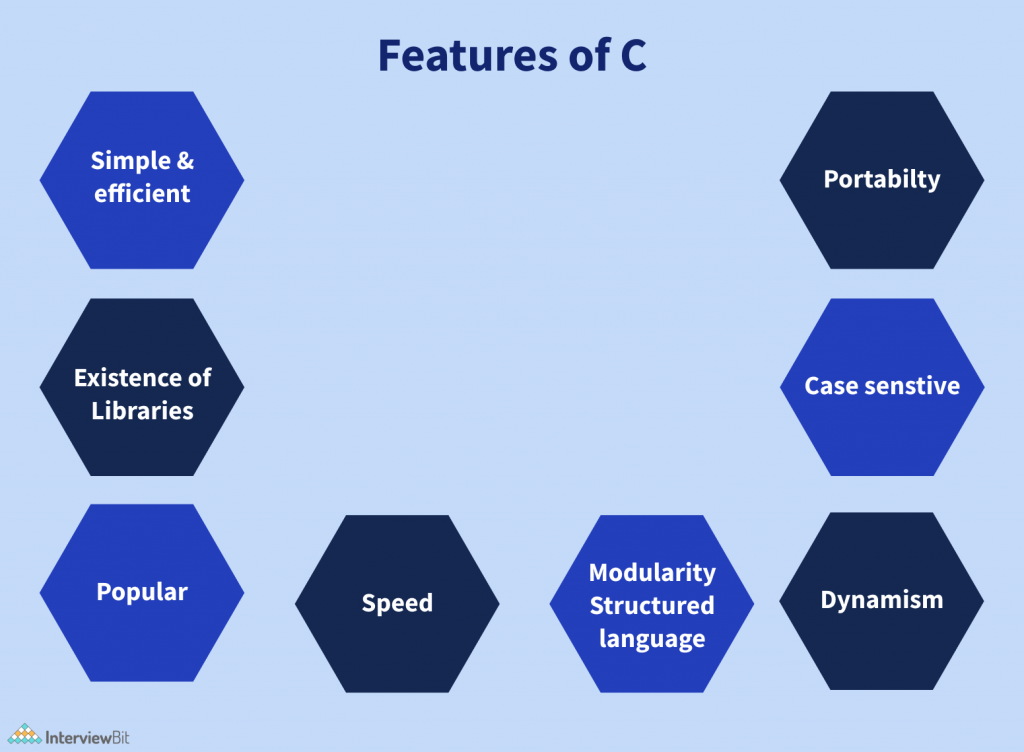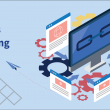Ah the C language! What can you say more about nostalgia and longevity? Not only C is one of the oldest surviving programming languages but also one that is on most of the lists of the top programming languages to use in 2023, and most probably will be in there in the coming years as well.
C is also sometimes referred to as the mother of all programming languages. It is so because, throughout its reign of almost five decades, it has influenced so many programming languages. C++, Java, etc. are a few popular programming languages that have taken inspiration (concepts, design patterns, etc.) from C.
As you can see, most of these languages are found in the best programming languages to learn charts. So, you see, C is a really old programming language that is still going strong.
Confused about your next job?
- What is C?
- Why is C So Popular?
- Why Use C?
- Top 11 Feaures of C Language
- 1. A Vibrant Set of Inbuilt Operators
- 2. C is Highly Extensible
- 3. Dynamic Memory Allocation
- 4. Fast and Performant
- 5. High Modularity
- 6. Follows the Procedural Programming Paradigm
- 7. Middle-Level Language
- 7. Pointers
- 8. Portability
- 9. Simple and Elegant
- 10. Suitable for Various Uses
- Conclusion
- FAQs
- Q.1: Which are the best features of C?
- Q.2: What makes the C language unique?
- Q.3: What’s so unique about C?
- Additional Resources
What is C?
C is a statically-typed programming language that can be classified as a procedural programming paradigm. This means everything in C is a procedure or function. C programs have a main function that is the first function and also responsible for starting as well as terminating the execution of the C programs.
Developed by Dennis Ritchie at Bell Labs, it also provides support for lexical variables scope, recursion, and structured programming. The intent of developing C was to overcome the challenges faced by B, BASIC, and BPCL programming languages. It became immensely popular during the 1980s for developing mainframes, microcomputers, and minicomputers.
Why is C So Popular?
There are several reasons that contribute to the popularity of a programming language. However, these reasons vary from language to language.
C is popular for many reasons. For example, it is a simple language that follows a structured approach to programming, i.e., it divides a problem into smaller subproblems and then solves them.
Also, C came way before all the popular programming languages of today. And also, many of those have concepts taken from the C programming language. Thanks to its low-level programming abilities, it is ideal for developing operating systems and compilers too.
Why Use C?
Well, there are several good reasons for a developer or programmer to pick up C. Although personal preferences and project requirements play the main role, the following are other convincing reasons to use the C programming language:
- C enables you to work closely with the hardware. This facilitates developing system software and makes it a top choice for system programming. Check any article on the best programming languages for system programming and you will find C rocking the charts!
- It came long before other popular programming languages, whether it be the data-science and ML-optimized Python or the backbone of the web, JavaScript. Thus, it has influenced modern programming languages in one way or another.
- C is faster than modern popular programming languages thanks to its no-frills syntax and having only the required features.
The C programming language is one of the most popular programming languages, probably because of all the previously-mentioned reasons.
Still not convinced. Well, that’s why we have compiled the “Top Features of the C Language” section below. A good time to make you a believer of C. So, let’s head-first!
Top 11 Feaures of C Language

C offers a galore of features. From the approach of structured programming and a machine-independent build to the simplicity and availability of pointers, C has many features that make it a good choice for a programming language. The following are the best C features:
1. A Vibrant Set of Inbuilt Operators
Operators are constructs in programming languages that perform specific operations on variables. Depending on the operand(s), operators can be arithmetic, comparison, logical, and so on. C has a wide array of inbuilt operators that helps to write basic as well as advanced programs.
2. C is Highly Extensible
Another reason that makes C a popular programming language is the high degree of extensibility that it offers. The capability of already-written C programs can be extended easily by adding more code to the same.
3. Dynamic Memory Allocation
C supports dynamic memory allocation. It simply means that it is possible to alter the size of a data structure in C during the run time. It is one of the most convincing features to use the C programming language.
Also, C comes with many prebuilt functions to deal with memory allocation. Calling the free() function, for instance, in C allows users to free allocated memory at any time required. Also, calloc(), malloc(), and realloc() are a powerful trio of memory management functions in C.
4. Fast and Performant
Newer programming languages offer a lengthier list of features than the C programming language. However, more features mean more processing. Hence, the performance of these languages goes down due to the same. C, on the other hand, with only the essential features is faster and more efficient because less processing is required. Also, C is a statically-typed language, and statically-typed languages are faster than dynamically-typed programming languages.
In statically-typed languages, the programmer needs to define the data type of the variables declared. In such languages, the variable type is checked only at the compile time and not at the run time. Unlike interpreter-based languages, C is a compiler-based programming language. This further enhances the speed of code compilation and execution.
5. High Modularity
Modularity, in the context of programming code, refers to the process of dividing an entire program into smaller individual units. This is achieved with functions, libraries, and modules in C. The concept of header files in C makes it a highly modular programming language.
The more modular a programming language is, the more reusable its code is. A greater degree of what C can accomplish is already available in the form of predefined functions stored in libraries, and C has a great selection of libraries. Some of the most popular C libraries are:
- BerkeleyDB
- checkedthreads
- Cranium
- Debug
- libsodium
- musl, etc.
Although the above are some of the most renowned C libraries, the most useful ones that you will find will be the ones that you will create yourself. Yes, C allows you to save functions in the form of libraries for future use. C libraries and functions help beginners to start coding with relative ease as well as save the effort of experienced developers in reinventing the wheel.
6. Follows the Procedural Programming Paradigm
A programming language can be classified into multiple programming paradigms and there are several of them, such as object-oriented, procedural, and functional.
Procedural programming is also known as imperative programming and it aims to improve the clarity, development time, and quality of computer programs. Following are some of the advantages that the procedural programming paradigm grants to C:
- Code is easily understandable.
- Implementation of algorithms becomes easy.
- Increases code reusability.
- The program flow is linear, hence tracking the same is easy.
C carries out instructions step-by-step. That’s because it is a procedural programming language. Everything in C is a function. A complete C program is divided into several tasks and every task is completed using a function.
7. Middle-Level Language
The C programming language is also referred to as a middle-level language. That’s because it offers low-level access to the computer hardware, i.e., it facilitates direct manipulation of the hardware and also has the features of a high-level language that were introduced over time via the various releases. This is a powerful combination that is among the best reasons to use C.
7. Pointers
Pointers are programming entities that point to a particular memory location. These allow developers to directly interact with the memory, which makes working with functions, arrays, and memory easier and more efficient.
Moreover, dynamic memory allocation, which is a major feature of C, is possible only because of pointers. A pointer is a variable that stores the memory address of some other variable as its value. Similar to other variables, you need to declare a pointer to use it.
8. Portability
Another top feature of C is portability. A C program written on one operating system can run and compile on any other OS with little to no machine-specific changes. This makes C a hardware-independent programming language, and also saves developers the effort to rewrite the same code over and over again to implement in different systems.
9. Simple and Elegant
Unlike modern programming languages, C is a simple programming language. It uses the traditional approach of dividing a big problem into smaller parts and then solving them individually to get the solution.
C features a no-frills syntax that is easy to learn and understand. This allows developers to create or rewrite a C program easily. Because of this very feature, C is used as an introductory programming language across schools and colleges, and also in professional programming courses.
10. Suitable for Various Uses
C is a general-purpose programming language. This means it is suitable for accomplishing various purposes, ranging from developing games and photo editing software to designing compilers and system software. Following are some of the best uses of C:
- Unix is developed using C. Microsoft Windows is also scripted in the C programming language. It is an excellent programming language for designing operating systems.
- Thanks to its ability to work closely with the hardware, C is an ideal choice for developing applications and drivers for embedded systems.
- C is ideal for developing graphical user interfaces. Adobe Illustrator, Adobe Photoshop, and Adobe Premiere are developed using the C programming language.
- Not only many modern programming languages but programming platforms are developed using C. Examples include MATLAB and Wolfram Mathematica.
Conclusion
Despite being a quinquagenarian, C still holds its ground firmly to stand tall among the best programming languages to learn in 2022. Although you are not going to get a high-paying job merely with C as the sole skill, pairing it with popular contemporary tools and technologies like Python, JavaScript, MySQL, NodeJS, Nginx, and Apache Server will allow you to get developer jobs that are high-paying and satisfying.
FAQs
Q.1: Which are the best features of C?
Ans: C offers a galore of features. High portability, speedier execution, availability of a good range of libraries, frameworks, and tools, and low-level hardware support are some of the best features of C.
Q.2: What makes the C language unique?
Ans: Factors like being five decades old but still ticking, flexible to be usable on a wide array of platforms, inspired by many popular programming languages, and offering low-level programming abilities make C a unique programming language.
Q.3: What’s so unique about C?
Ans: C is a mid-level language which means you can use it for high-level programming as well as system programming. Also, C is probably the only language the knowledge of which will allow you to learn many other popular programming languages. This is because many of these are inspired by C.




